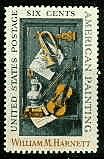
William Harnett led an American revival of ancient Roman interest in “fooling the eye” with illusionist paintings so carefully rendered that they cause a viewer to interpret the subjects as existing three-dimensional objects.
Harnett’s skillful use of perspective and careful detailing of life-size objects has thrust the Philadelphia painter into the forefront of 19th century American artists. It also landed him on a U.S. stamp celebrating his considerable skills.
After training in silver engraving and schooling on the Italian Renaissance at the Academy of Fine Arts in Philadelphia, William M. Harnett took up the brush in 1873. He favored still lifes after the manner of Raphaelle Peale, but soon treated his admirers to a new way of seeing. His illusionist statements possessed verisimilitude, that is they looked real. “You could pull the necktie from the subject’s vest,” an admirer claimed.
Harnett favored every day items in his trompe l’oeil paintings. He depicted such things as Colt revolvers or horseshoes hanging on nails in the wall giving perfect illusion of three-dimensional objects in two-dimensional spaces.
Even at close range his shadowing and sensitivity to highlights made the viewer feel real objects were shown. His hunting scenes were so realistic, observers felt real rabbits and fowl were hanging on a door panel.
Harnett contended that he was not merely imitating nature. He was purifying what he saw, distilling reality with his brush strokes. Harnett said that he both added to and subtracted from reality, but created the illusion that the content of his painting was “real.”
Nevertheless many in the art establishment apostrophized Harnett’s “art,” labeling it “painting by recipe.” Others demeaned the canvasses with the execrable lament that photography does it better.
Yet the public enjoyed Harnett’s painterly deception, which often debuted in such ordinary but bustling venues as saloons and pharmacies. Oohs and aahs greeted presentations of his canvasses. This acclaim and its financial rewards rankled the scholarly academicians, of course.
During the Eighties, Harnett found immense popularity and fortune. His world famous After the Hunt accomplished in 1885 in Paris displayed dead game, weapons and the other accouterments of the sport as nailed to a scratched wooden door.
This trophy theme is one to which the artist returned over and over again. He sold a final version on this theme to a New York saloon keeper who hung it with much fanfare in his bar. This brought on a host of imitations by less skilled practitioners.
Wagers were often laid and lost as to whether the objects on Harnett’s canvas were painted or real. Of course, his was no work of collage.
One of Harnett’s most successful themes were paintings depicting U.S. currency and bank notes. His remarkable likenesses were so good they fooled critics, but not the federal government who seized his work as being too closely imitative of real notes.
Proving that the federal government doesn’t hold a grudge, or has a short memory, William Harnett was honored by a U.S. stamp. Philatelists should be aware of the plethora of Harnett “miniatures,” produced in 1969 in connection with the release of a commemorative stamp honoring the painter. Depicting the artist’s painting Old Models from the collection of Boston’s Museum of Fine Arts, the six-cent stamp is cataloged as Scott #1386.
More than 400,00 first day covers were produced for the stamp’s release Dec. 8, 1969. All the major cover makers produced cachets for the event including Fleetwood, Artcraft and Cover Craft. Specimens of these covers are frequently available for a dollar or less. The BEP produced nearly 150 million of stamps, so acquiring one’s very own Harnett should not prove too difficult a chore.
Fred Reed is former News Editor of Coin World and Vice-President of Beckett Publications. A collector for over 40 years, Reed is a member of most national coin and stamp organizations. He is also Secretary of Society of Paper Money Collectors. SPMC awarded Reed its lifetime achievement award for his groundbreaking Civil War Encased Stamps: The Issuers and Their Times, one of his five books. Reed has also written on coins and currency, tokens and medals, stamps, comic books, post cards, Beanie Babies, sports cards and collectibles, engravings and lithographs, movie memorabilia, autographs, antique photography, and Civil War artifacts, all of which he avidly collects. Reed is a long-time member of the American Society of Magazine Editors, the Dallas Press Club and the Society for American Baseball Research.
Fred Reed is former News Editor of Coin World and Vice-President of Beckett Publications. A collector for over 40 years, Reed is a member of most national coin and stamp organizations. He is also Secretary of Society of Paper Money Collectors. SPMC awarded Reed its lifetime achievement award for his groundbreaking Civil War Encased Stamps: The Issuers and Their Times, one of his five books. Reed has also written on coins and currency, tokens and medals, stamps, comic books, post cards, Beanie Babies, sports cards and collectibles, engravings and lithographs, movie memorabilia, autographs, antique photography, and Civil War artifacts, all of which he avidly collects. Reed is a long-time member of the American Society of Magazine Editors, the Dallas Press Club and the Society for American Baseball Research.